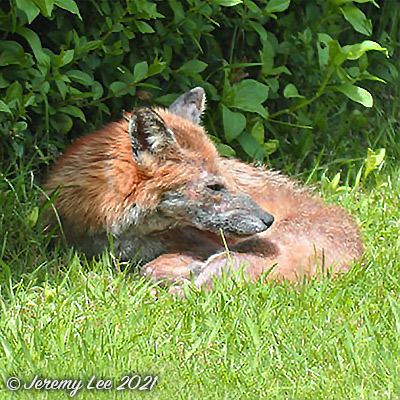
 |
|
Scientific Classifications explained » Amphibians » Ants » Aphids » Bees » Beetles » Birds » Bugs » Butterflies » Caterpillars » Damselflies » Dragonflies » Earwigs » Flies » Frog/Leafhoppers » Fungi » Galls » Grasshoppers » Harvestmen » Hoverflies » Lacewings » Ladybirds » Leaf Mines » Lichens » Mammals » Millipedes » Mosses » Moths » Sawflies » Slugs » Snails » Spiders » Trees & Shrubs » Wasps » Wild Flowers » Woodlice » Postboxes |
UK Nature > Mammals > Vulpes vulpes

Scientific Name: Vulpes vulpes Common Name: European Red Fox Vulpes vulpes, otherwise known as the European Red Fox, is a common and familiar mammal, our only wild member of the dog family. It is omnivorous, feeding on small mammals, birds, frogs, earthworms and carrion, as well as berries and fruit. It is just as likely to be seen in towns and cities, as it is in the countryside; and it is now well-known for scavenging food scraps from bins, as well as catching feral pigeons and Brown rats. Males ('dogs') bark, but females ('vixens') make a spine-chilling scream, heard mostly in the winter when their courtship takes place. Red foxes live in a burrow system called an 'earth'. They scent-mark their territorial borders with urine, creating a very strong, recognisable odour. They also have scent glands on their feet to mark well-used trails so they can follow them easily at night. A medium-sized dog, the red fox is orangey-red above, white below, with black tips to the ears, dark brown feet and a white tip to the bushy, orange tail (known as the 'brush'). Widespread throughout the UK, but absent from the Channel Islands, the Isles of Scilly, Scottish islands and the Isle of Man. Note: the fox shown above appears to be suffering from sarcoptic mange (sarcoptes scabeii), which is the single most common infection in foxes. |
|

https://www.uknature.co.uk is a website dedicated to showing the immense diversity of UK nature and wildlife. Our vast range of habitats, from lowland arable to snow covered mountains, from storm-ravaged coastlines to peaceful inland freshwater lakes and rivers, from dry, sandy heaths to deciduous and coniferous forests, all these habitats contribute to the abundance of UK nature. We have wild birds in huge numbers either residing or visiting our shores (597 recorded species as at July 2013) and we must also not forget the humble back garden with its grass lawns, flower beds filled with nectar rich flowers, shrubs and trees, all designed to attract huge numbers of insects such as bees, moths, butterflies and hoverflies; and finally the small ponds which provide safe havens for frogs, toads, newts and even slow worms and grass snakes. www.uknature.co.uk is the showcase for my personal passion, photographing uknature in all its glory. I sincerely hope you all enjoy the fruits of my labours. This site and all images contained therein is © Jeremy Lee 2004 - 2025. All Rights Reserved. Site design by Jeremy Lee. Site development & IT Support by Stuart Lee. |